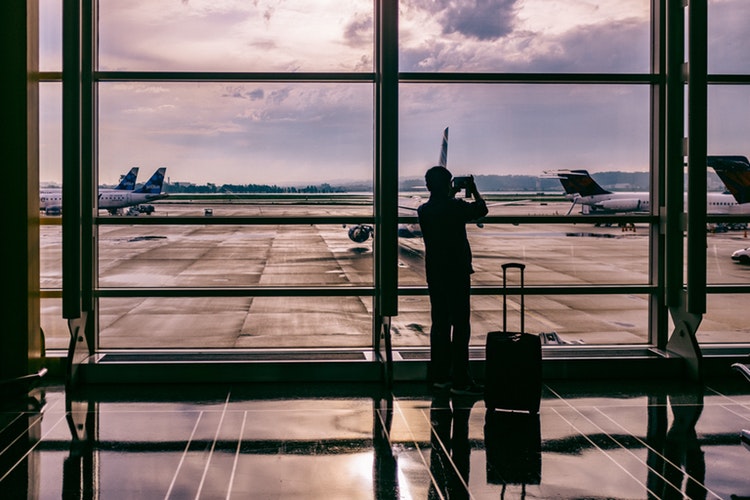Fly me to the moon: Are we subsidising a climate apocalypse?
Many of us would like to travel in an environmentally-responsible way, but carbon-guzzling flights often seem both faster and cheaper than greener options. With children protesting for action on the environment, it’s time for tough questions. How can aviation possibly be this cheap, what is it really costing us and are we subsidising a climate apocalypse?
If you’re looking to book a trip, there are almost too many flight price comparison websites to choose from, all claiming to help you find the cheapest air tickets. But what about a comparison revealing the true cost of your journey? Research undertaken by the German broadcaster Deutsch Welle (DW) does just that, analysing face-value ticket prices on six direct European routes, then costing in other factors.
On half the routes they compared, the plane was cheaper than the train in sheer monetary terms. Next, they factored in time. Yes, the flights were all shorter, by two and a half to six and a half hours, but hang on, not so fast. DW then added (a perhaps slightly exaggerated) three hours to flight times, to account for travel to and from airports, going through security, plus gate and runway waiting time.
Once carbon emissions are also considered, the true cost of plane travel really begins to become clear. Using figures from the Institute for Energy and Environmental Research (IFEU), DW calculated CO2 emissions for their selected journeys. Train journey emissions were then compared to this by examining how various countries produce their electricity and their mix of coal, gas, oil, and renewables.
Take-off and landing burn the most fuel, so short-haul flights use more fuel per kilometre than long-distances. After taking all that into account, it’s no surprise to discover that every single train trip on DW’s list was lower in overall ‘costs’ than the plane. Didn’t we already know that, in our hearts? Would knowing this change your behaviour?
As we stare climate catastrophe in the face, is it right to leave individual consumers to make their own emissions choices? With our own busy lives to navigate, how are we supposed to weigh up what uses of carbon are ‘worth it’? Did you know, for example, that a single Boeing 747’s full tank of 200,000 litres of kerosene could heat 440 houses (of around 300 sq metres) continuously for two winter months. Interesting maybe, but instead of desperate analogies, we need an internationally-agreed method for calculating the social cost, or ‘shadow price’ of carbon (SCC). One way to do it, in our cash-obsessed world, is to assign a monetary value to the damage done by emitting a set amount of carbon. For example, the US Environmental Protection Agency calculates the social cost of carbon at $42 per metric tonne. Other analysts think that estimate is far too low. Much is at stake: this figure could influence how much future taxes on air travel should be.
However, using taxes to disincentivise air travel seems very far away right now. In fact, aviation fuel is untaxed. Worse still, the USA under Trump has created a boom in private jet use, by allowing both firms and individuals to offset 100% of the cost of a new or used private jet against federal taxes. Meanwhile, in Europe, businesses and private citizens can dodge value-added tax on imported private jets by channelling purchases via the Isle of Man. This has slashed tax bills by $1bn on a minimum of 200 aircraft since 2011.

A half-full private jet is twelve times dirtier than economy air travel. Looking at this, it’s easy to become disheartened or cynical: if billionaires won’t pay the price for their environmental delinquency, why should ‘us ordinary folk’ be expected to give up our package holidays to Greece? But before you use your high horse to ride away from your environmental responsibilities, remember: it’s estimated that less than five percent of the world’s population has ever flown on a plane, so check your privilege, as the saying goes.
The shocking truth is that questionable taxation is just the tip of the iceberg when it comes to our governments’ attitude to the aviation industry. A 2017 review of Subsidies in Aviation authored by Prof. Stefan Gössling, Frank Fichert, and Peter Forsyth, finds that ‘significant subsidies are extended to manufacturers, infrastructure providers and airlines.’ Why? And what form do these subsidies take?
Aviation first began receiving subsidies as an emerging industry and in the name of defence, and the practice hasn’t ceased today, even though by the 1950s air travel could hardly be described as a new phenomenon. These days the main explanation for handouts is that aviation is a source of economic growth and high-tech employment, with the Air Transport and Action Group estimating the sector supports 65.5 million jobs and $2.7 trillion in global economic activity. But doubt is cast on these claims by double counting practices, inappropriate multipliers and the complexity of assessing direct, indirect and induced employment.

What we do know is that hundreds of billions of US$ have been paid to manufacturers, infrastructure providers and airlines globally since the 1950s and annual subsidies remain substantial today, even though many are considered ‘harmful’ by the OECD.
Examples of subsidies identified in Gössling’s study include research and development grants, export easers, loss coverage, equity infusions, loans and loan guarantees, reduced infrastructure fees, monopoly rights and zero or reduced taxes. Information about this funding is rarely in the public domain, and often only comes to light because of cases brought to dispute resolution bodies.
Never fear though, there’s a wealth of these ‘cases’ to draw from because the ethics of aviation subsidies are in constant dispute. To cite just a few, a five-year clash between Brazil and Canada took place between 1996 and 2001 over export-financing for regional aircraft, leading to three cases at the World Trade Organisation. The European Airbus programme created controversy between the USA and Europe, with tit-for-tat accusations of illegal state aid. And the industry is touted to receive yet more state aid as Russia and China seek to re-establish commercial aircraft manufacturing.
How can we justify allowing these practices to continue? Unless you’re a climate change denier, it’s hard not to see such subsidies as an unacceptable use of public funds: governments across the world are effectively financing a future climate apocalypse. A new look at aviation is urgently needed, before we really do need someone to fly us to the moon – or further.




